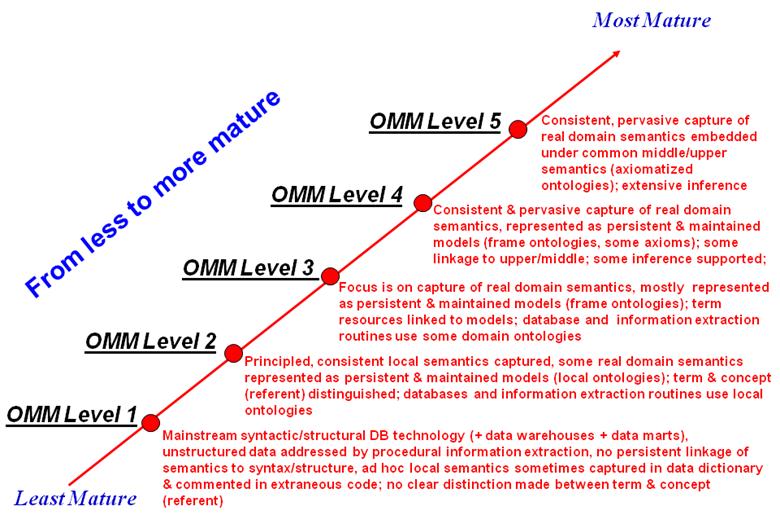Also, as you know, Bob, the Capability Maturity Model Integration [CMMI 1] (which is what Appendix B is from in that MITRE report) is a maturity model for general
software practice and process. As Royce (2002) [2] notes, the CMM [3], was focused on activity-based, not results-based measures, and so in [2] the perspective is that of looking back at the lessons learned from the now deprecated CMM in lieu of the new Capability
Maturity Model Integration (CMMI). The CMMI tries to correct that emphasis. The resulting changes are reflected in the usual table:
CMMI Levels
|
Level
|
Description
|
|
Level 1 (initial)
|
Describes a process maturity characterized by unpredictable results
|
|
Level 2 (managed)
|
Characterized by repeatable project performance
|
|
Level 3 (defined)
|
Characterized by improving organizational project performance including: multi-stakeholder requirements evolution, evolutionary design/quality engineering, continuous integration, verification and validation, risk management, training,
process focus, decision analysis/resolution, treating process as a persistent evolving asset of an organization, integrated project management
|
|
Level 4 (quantitatively managed)
|
Characterized by improving organizational performance, e.g., exploiting historical results to make trade-offs with predictable results among competing dimensions of performance, setting norms/benchmarks; quantitative project management
|
|
Level 5 (optimizing)
|
Characterized by rapidly reconfigurable organizational performance; quantitative, continuous process improvement; proactive fault avoidance and best practice reinforcement; institutional learning, organic adaptation and improvement
|
Although the CMM and CMMI, being software development focused, cannot directly guide the development of a controlled vocabulary and ontology maturity model,
their level distinctions, criteria for evaluation of the level/maturity at which a given organization is gauged to reside, and focus on quantitative results-based measures [2], are clearly adaptable by an ontology maturity model.
Here is an Ontology Maturity Model I proposed in [4]:

And you can read the excerpt I provided for reference to Ontology Summit 2011 [5].
[1] Capability Maturity Model Integration. CMMI. Software Engineering Institute, Carnegie Mellon University.
http://www.sei.cmu.edu/cmmi/general/
[2] Royce, Walker, 2002. CMM vs. CMMI: From Conventional to Modern Software Management. The Rational Edge: E-Zine for the Rational Community, February, 2002.
Rational Software Corporation. Avaliable: http://www-128.ibm.com/developerworks/rational/library/content/RationalEdge/feb02/ConventionalToModernFeb02.pdf (November 11, 2008).
[3] Capability Maturity Model. CMM.
http://en.wikipedia.org/wiki/Capability_Maturity_Model.
[4] Obrst, Leo. 2010. Ontological Architectures. Chapter 2, pp. 27-66 in the book: TAO – Theory and Applications of Ontology: Computer Applications, Roberto
Poli, Johanna Seibt, Achilles Kameas, eds. September, 2010, Springer.
[5]
http://ontolog.cim3.net/file/work/OntologySummit2011/reference/ontologyMaturityModel-obrst-2009.pdf.
From: ontology-summit-bounces@xxxxxxxxxxxxxxxx [mailto:ontology-summit-bounces@xxxxxxxxxxxxxxxx]
On Behalf Of Denny, Michael S.
Sent: Monday, February 18, 2013 4:52 PM
To: Ontology Summit 2013 discussion
Subject: Re: [ontology-summit] {software-environment} Feedback on software capabilities to be included in the upcoming Survey
Thanks for your input, Bob. The question is which particular quality and fitness factors of the resulting ontology are improved by using an agile development
approach? Mike
From:
ontology-summit-bounces@xxxxxxxxxxxxxxxx [mailto:ontology-summit-bounces@xxxxxxxxxxxxxxxx]
On Behalf Of Bob Smith
Sent: Monday, February 18, 2013 4:13 PM
To: Ontology Summit 2013 discussion
Subject: Re: [ontology-summit] {software-environment} Feedback on software capabilities to be included in the upcoming Survey
Hello Mike -
Ontology Editors and tools have evolved and will continue to evolve...
The Price and availability for medium and small sized organizations and standards development organizations is an important issue.
I am currently involved with the Architects - Engineers - Contractors effort at the National Institute of Building Science to use ontology editing tools or even topic maps as we define terms and relationships between
terms.
We have a huge investment in "Life Cycle Phases" and physical document hand-overs, while attempting to become digital and web friendly (while failing to directly address XML and related langages).
So there is a facet of your survey dealing with an ontology tool's ability to leverage collaboration across domains and institutional gaps which is too implicit.
How "Main Stream" is the tool today? Does it play well with Cloud Computing Strategies and Agile-Lean development?
Is it (the tool) compatible with the features that MITRE developed in their 107 page document for Teri Takai - CIO of the DoD? Especially Appendix B - comparing two paradigms.
Handbook for Implementing Agile in Department of Defense Information
building SMART alliance Term Definition Committee
On Mon, Feb 18, 2013 at 12:07 PM, Denny, Michael S. <msdenny@xxxxxxxxx> wrote:
oops, I forgot the reference
-----Original Message-----
From: ontology-summit-bounces@xxxxxxxxxxxxxxxx [mailto:ontology-summit-bounces@xxxxxxxxxxxxxxxx] On Behalf Of Peter Yim
Sent: Monday, February 18, 2013 3:06 PM
To: Ontology Summit 2013 discussion
Subject: Re: [ontology-summit] {software-environment} Feedback on software capabilities to be included in the upcoming Survey
Thanks, Mike.
Note details on the Feb-14 session page ... and, in particular,
MikeDenny's (and the other panelists) slides can be found under:
http://ontolog.cim3.net/cgi-bin/wiki.pl?ConferenceCall_2013_02_14#nid3MFH
Regards. =ppy
--
On Mon, Feb 18, 2013 at 11:48 AM, Denny, Michael S. <msdenny@xxxxxxxxx> wrote:
> All,
>
>
>
> We are looking for final feedback on the set of software capabilities that
> were listed in Michael Denny's Ontology Summit presentation of 14 February.
> This list is intended to identify those software capabilities that may
> address, across the ontology life cycle, any of the ontology quality &
> fitness factors identified in Tracks A-C. The Ontology Evaluation Survey
> will be composed next week based on that list and feedback received by this
> Friday the 22nd. Thanks for those contributions already made and those yet
> to come.
>
>
>
> Best,
>
> Mike
_________________________________________________________________
Msg Archives:
http://ontolog.cim3.net/forum/ontology-summit/
Subscribe/Config:
http://ontolog.cim3.net/mailman/listinfo/ontology-summit/
Unsubscribe: mailto:ontology-summit-leave@xxxxxxxxxxxxxxxx
Community Files:
http://ontolog.cim3.net/file/work/OntologySummit2013/
Community Wiki:
http://ontolog.cim3.net/cgi-bin/wiki.pl?OntologySummit2013
Community Portal: http://ontolog.cim3.net/wiki/
_________________________________________________________________
Msg Archives:
http://ontolog.cim3.net/forum/ontology-summit/
Subscribe/Config:
http://ontolog.cim3.net/mailman/listinfo/ontology-summit/
Unsubscribe: mailto:ontology-summit-leave@xxxxxxxxxxxxxxxx
Community Files:
http://ontolog.cim3.net/file/work/OntologySummit2013/
Community Wiki:
http://ontolog.cim3.net/cgi-bin/wiki.pl?OntologySummit2013
Community Portal: http://ontolog.cim3.net/wiki/
|
_________________________________________________________________
Msg Archives: http://ontolog.cim3.net/forum/ontology-summit/
Subscribe/Config: http://ontolog.cim3.net/mailman/listinfo/ontology-summit/
Unsubscribe: mailto:ontology-summit-leave@xxxxxxxxxxxxxxxx
Community Files: http://ontolog.cim3.net/file/work/OntologySummit2013/
Community Wiki: http://ontolog.cim3.net/cgi-bin/wiki.pl?OntologySummit2013
Community Portal: http://ontolog.cim3.net/wiki/ (01)
|
